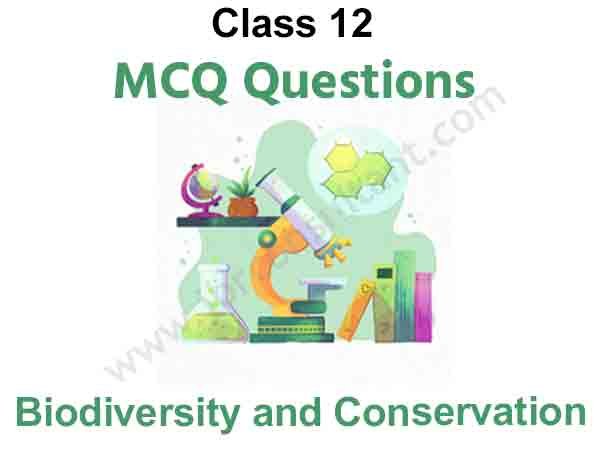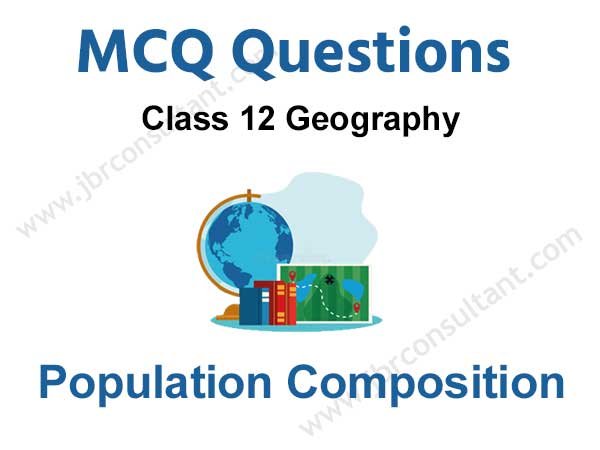Class 12 Biodiversity and Conservation MCQ is one of the best strategies to prepare for the CBSE Class 12 Board exam. If you want to complete a grasp concept or work on one’s score, there is no method except constant practice. Students can improve their speed and accuracy by doing more MCQ on Biodiversity and Conservation class 12, which will help them all through their board test.
Class 12 Biodiversity and Conservation MCQ Questions with Answers
Class 12 Biology MCQ with answers are given here to chapter the Biodiversity and Conservation. These MCQs are based on the latest CBSE board syllabus and relate to the latest Class 12 Biology syllabus. By Solving these Biodiversity and Conservation MCQs, you will be able to analyze all of the concepts quickly in the chapter and get ready for the Class 12 Annual exam.
Learn Biodiversity and Conservation Class 12 MCQs with answers pdf free download according to the latest CBSE and NCERT syllabus. Students should prepare for the examination by solving CBSE Class 12 Biodiversity and Conservation MCQ with answers given below.
Question 1. Which of the following regions of the globe exhibits highest species diversity?
(a) Western Ghats of India
(b) Madagascar
(c) Himalayas
(d) Amazon forests
Answer
D
Question 2. The trees occurring in two seasons is the characteristic feature of
(a) temperate deciduous forest
(b) tropical savannah
(c) grassland
(d) coniferous forest
Answer
A
Question 3. The species confined to a particular region and not found elsewhere is termed as
(a) endemic
(b) rare
(c) keystone
(d) alien.
Answer
A
Question 4. Which of the following is the most serious threat to biodiversity?
(a) Competition from exotic species
(b) Commercial harvesting
(c) Habitat loss
(d) Overexploitation
Answer
C
Question 5. Which one of the following have the highest number of species in nature?
(a) Fungi
(b) Insects
(c) Birds
(d) Angiosperms
Answer
B
Question 6. Which one of the following is a pair of endangered species?
(a) Garden lizard and Mexican poppy
(b) Rhesus monkey and sal tree
(c) Indian peacock and carrot grass
(d) Hornbill and Indian aconite
Answer
D
Question 7. Which one of the following is not included under in situ conservation?
(a) National park
(b) Sanctuary
(c) Botanical garden
(d) Biosphere reserve
Answer
C
Question 8: What is common to Lantana, Eichhornia and African catfish?
a) All the species are neither threatened nor indigenous species of India.
b) All are mammals found in India.
c) All are key stone species
d) All are endangered species of India
Answer
A
Question 9: Which of the following group of plants exhibit more species diversity?
a) Fungi
b) Bryophytes
c) Algae
d) Angiosperms
Answer
A
Question 10. Which one of the following is not a method of in situ conservation of biodiversity ?
(a) Sacred grove
(b) Biosphere reserve
(c) Wildlife sanctuary
(d) Botanical garden
Answer
D
Question 11. From origin of life to its diversification on earth, there have occurred following number of episodes of mass extinction.
(a) Two
(b) Three
(c) Four
(d) Five
Answer
D
Question 12. Genetic diversity in agricultural crops is threatened by
(a) introduction of high yielding varieties.
(b) intensive use of fertilizers.
(c) extensive intercropping.
(d) intensive use of biopesticides.
Answer
D
Question 13. Occurrence of endemic species in South America and Australia is due to
(a) these species has been extinct from other regions
(b) continental separation
(c) there is no terrestrial route to these places
(d) retrogressive evolution.
Answer
B
Question 14. Which one of the following is not used for ex-situ plant conservation?
(a) Shifting cultivation
(b) Botanical gardens
(c) Field gene banks
(d) Seed banks
Answer
A
Question 15. Which part of the world has a high density of organism?
(a) Deciduous forests
(b) Grasslands
(c) Tropical rain forests
(d) Savannahs
Answer
C
Question 16. Renewable source of energy is
(a) biomass
(b) coal
(c) petroleum
(d) kerosene
Answer
A
Question 17. In your opinion, which is the most effective way to conserve the plant diversity of an area?
(a) By tissue culture method
(b) By creating biosphere reserve
(c) By creating botanical garden
(d) By developing seed bank
Answer
B
Question 18: What is common to the following plants: Nepenthes, Psilotum, Rauwolfia and Aconitum?
a) All are prone to over exploitation
b) All are phylogenic link species
c) All are ornamental plants
d) All are exclusively present in the Eastern Himalayas
Answer
A
Question 19. Select the correct statement about biodiversity.
(a) The desert areas of Rajasthan and Gujarat have a very high level of desert animal species as well as numerous rare animals.
(b) Large scale planting of Bt cotton has no adverse effect on biodiversity.
(c) Western ghats have a very high degree of species richness and endemism.
(d) Conservation of biodiversity is just a fad pursued by the developed countries.
Answer
C
Question 20. Alexander von Humboldt described for the first time
(a) laws of limiting factor
(b) species area relationships
(c) population growth equation
(d) ecological biodiversity.
Answer
B
Whoever needs to take the CBSE Class 12 Board Exam should look at this MCQ. To the Students who will show up in CBSE Class 12 Biology Board Exams, It is suggested to practice more and more questions. Aside from the sample paper you more likely had solved. These Class 12 Biodiversity and Conservation MCQ are ready by the subject specialists themselves.
Question 21. Largest amount of fresh water is found in
(a) lakes and streams
(b) underground
(c) polar ice and glaciers
(d) rivers
Answer
C
Question 22. A tree species in Mauritus failed to reproduce because of the extinction of a fruit-eating bird. Which one of the following was that bird?
(a) Dove
(b) Dodo
(c) Condor
(d) Skua
Answer
B
Question 23. MAB stands for
(a) mammals and biosphere
(b) mammals and biology programme
(c) man and biology programme
(d) man and biosphere programme.
Answer
D
Question 24. Which one of the following is related to ex-situ conservation of threatened animals and plants?
(a) Biodiversity hotspots
(b) Amazon rainforest
(c) Himalayan region
(d) Wildlife safari parks
Answer
D
Question 25. Which one of the following is an example of ex-situ conservation?
(a) Wildlife sanctuary
(b) Seed bank
(c) Sacred groves
(d) National park
Answer
B
Question 26. The Indian rhinoceros is a natural inhabitant of which one of the Indian states?
(a) Uttarakhand
(b) Uttar pradesh
(c) Himachal Pradesh
(d) Assam
Answer
D
Question 27. Which of the following is the most important cause of animals and plants being driven to extinction?
(a) Habitat loss and fragmentation
(b) Co-extinctions
(c) Over-exploitation
(d) Alien species invasion
Answer
A
Question 28. Which of the following is not a cause for loss of biodiversity?
a) Keeping animals in zoological parks
b) Invasion by alien species
c) Destruction of habitat
d) Over-exploitation of natural resources
Answer
A
Question 29. One of the endangered species of Indian medicinal plants is that of
(a) Ocimum
(b) garlic
(c) Nepenthes
(d) Podophyllum.
Answer
D
Question 30. The largest Tiger reserve in India is
(a) Nagarhole
(b) Valmiki
(c) Nagarjunsagar-Srisailam
(d) Periyar
Answer
C
Question 31. Which of the following represent maximum number of species among global biodiversity?
(a) Fungi
(b) Mosses and Ferns
(c) Algae
(d) Lichens
Answer
A
Question 32. Flamingoes breed in
(a) Rann of Kutch
(b) Chilka lake
(c) Sambhar lake
(d) Lake Mansarover
Answer
B
Question 33. The abundance of a species population, within its habitat, is called
(a) relative density
(b) regional density
(c) absolute density
(d) niche density.
Answer
D
Question 34. Which of the following is the matching pair of a sanctuary and its main protected wild animal?
(a) Kaziranga-Musk deer
(b) Gir-Lion
(c) Sunderban-Rhino
(d) All of these
Answer
B
Question 35. In your opinion, which is the most effective way to conserve the plant diversity of an area?
(a) By tissue culture method
(b) By creating biosphere reserve
(c) By creating botanical garden
(d) By developing seed bank
Answer
B
Question 36.One endangered species of Indian medicinal plants is that of
(a) Podophyllum
(b) Ocimum
(c) Garlic
(d) Nepenthes
Answer
A
Question 37. Which type of living organisms given below are listed in Red Data Book”?
(a) Rare species
(b) Rare and endangered species
(c) Endangered species
(d) None of these
Answer
B
Question 38. Which endangered animal is the source of the world’s finest, lightest, warmest and most expensive wool – the shahtoosh?
(a) Nilgai
(b) Cheetal
(c) Kashmiri goat
(d) Chiru
Answer
D
Question 39. Alpha diversity is present
(a) within community.
(b) between community.
(c) ranges of communities.
(d) all of the above.
Answer
A

You can easily get good marks If you study with the help of Class 12 Biodiversity and Conservation MCQ. We trust that information provided is useful for you. NCERT MCQ Questions for Class 12 Reproduction in Organisms PDF Free Download would without a doubt create positive results.
We hope the information shared above in regards to MCQ on Biodiversity and Conservation Class 12 with Answers has been helpful to you. if you have any questions regarding CBSE Class 12 Biodiversity and Conservation MCQ Pdf, write a comment below and we will get back to you as soon as possible.
Frequently Asked Question (FAQs)
How many MCQ questions are there in CLass 12 chapter 15 Biology?
In Class 12 chapter 15 Biology, we have provided 39 Important MCQ Questions, But in the future, we will add more MCQs so that you can get good marks in the Class 12 exam.
Can we score good marks in Class 12 Biology with the help of Biodiversity and Conservation MCQ Questions?
Yes, MCQ Question is one of the best strategies to make your preparation better for the CBSE Board Exam. It also helps to know the student’s basic understanding of each chapter. So, You can easily score good marks in the Class 12 BIology exam.


